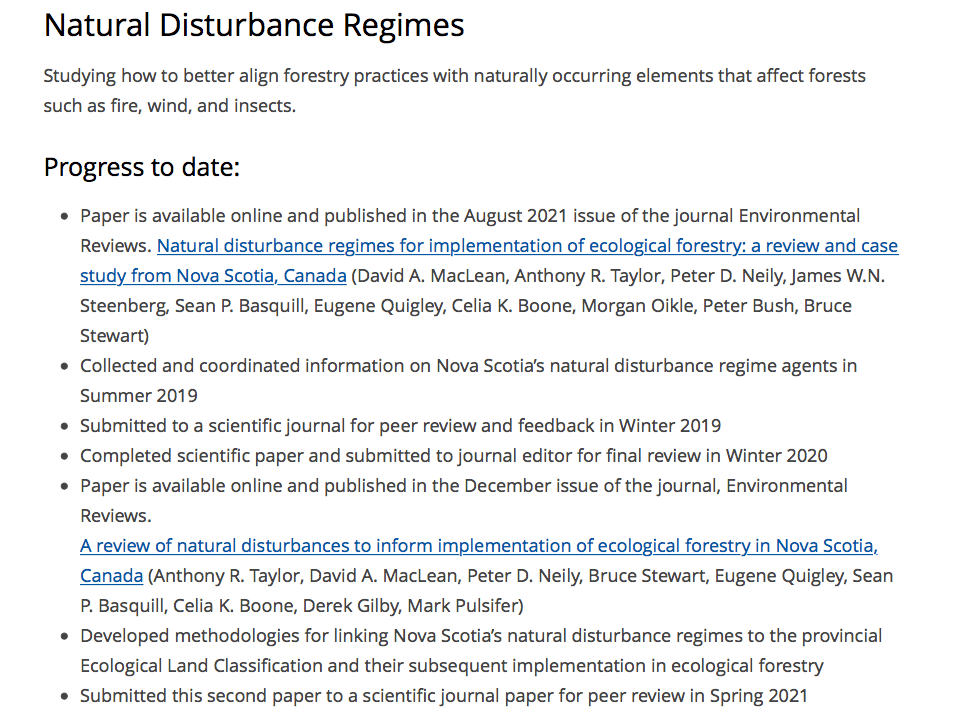Natural disturbance regimes for implementation of ecological forestry: a review and case study from Nova Scotia, Canada
Authors: David A. MacLean, Anthony R. Taylor, Peter D. Neily, James W.N. Steenberg, Sean P. Basquill, Eugene Quigley, Celia K. Boone, Morgan Oikle, Peter Bush, and Bruce Stewart
Journal: Environmental Reviews 4 August 2021 (Open Access paper)
ABSTRACT (paragraphing inserted)
Ecological forestry is based on the idea that forest patterns and processes are more likely to persist if harvest strategies produce stand structures, return intervals, and severities similar to those from natural disturbances.
Taylor et al. (2020) reviewed forest natural disturbance regimes in Nova Scotia, Canada, to support implementation of ecological forestry. In this follow-up paper, we (i) review the use of natural disturbance regimes to determine target harvest rotations, age structures, and residual stand structures; and (ii) describe a novel approach for use of natural disturbance regimes in ecological forestry developed for Nova Scotia.
Most examples of ecological forestry consider only the local, dominant disturbance agent, such as fire in boreal regions. Our approach included: (i) using current ecological land classification to map potential natural vegetation (PNV) community types; (ii) determining cumulative natural disturbance effects of all major disturbances, in our case fire, hurricanes, windstorm, and insect outbreaks for each PNV; and (iii) using natural disturbance regime parameters to derive guidelines for ecological forestry for each PNV.
We analyzed disturbance occurrence and return intervals based on low, moderate, and high severity classes (<30, 30–60, and >60% of biomass of living trees killed, respectively), which were used to determine mean annual disturbance rates by severity class. Return intervals were used to infer target stand age-class distributions for high, moderate, and low severity disturbances for each PNV.
The range of variation in rates of high severity disturbances among PNVs was from 0.28%·year–1 in Tolerant Hardwood to 2.1%·year–1 in the Highland Fir PNV, equating to return intervals of 357 years in Tolerant Hardwood to 48 years in Highland Fir PNVs. As an example, this return interval for the Tolerant Hardwood PNV resulted in target rotation lengths of 200 years for 35% of the PNV area, 500 years for 40%, and 1000 years for 25%.
The proposed approach of determining natural disturbance regimes for PNV communities and calculating target disturbance rates and corresponding harvest rotation lengths or entry times appears to be a feasible method to guide ecological forestry in any region with a strong ecological land classification system and multiple disturbance agents.
Timing
Oct 13, 2020: Received from Naomi Arron, Senior Strategist, Nova Scotia Department of Lands and Forestry in response to an inquiry: “The department’s NDR project team is working towards submitting a scientific paper on the application of natural disturbance regimes to a journal for consideration and peer review in Spring 2021. Acceptance and the timing of publication will depend on the journal.” An earlier request for stakeholder engagement in relation to the 2nd phase of the NDR Project was turned down – view correspondence.
On Feb 2, 2022, I checked the Ecological Forestry page for any announcement of the second published paper expected from the Natural Disturbance Regime Project. There were no updates about it. She replied on Feb 4, 2022 that ““The scientific paper on the application of natural disturbance regimes was peer-reviewed and published in Environmental Reviews in August 2021.” It had not occurred to anyone at NRR, apparently, to update the Natural Disturbance Regimes Project on the web page that is supposed to keep us all abreast of what’s going on, re Implementation of Ecological Forestry and the Communications Strategy. The page was updated after Feb 2 to read as below:

For some comments on this second paper, see NSFN Post Feb 4, 2022
